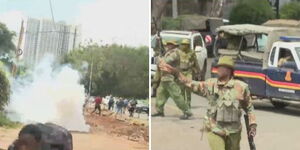Energy Cabinet Secretary Opiyo Wandayi has revealed the cause of the nationwide blackout that struck the country on Friday, September 6, revealing that it stemmed from the tripping of the Suswa substation.
According to the CS, the outage was triggered by a failure in the 220kV Loiyangalani transmission line, which was evacuating 288MW from the Lake Turkana Wind Power (LTWP) plant.
"The tripping of the Suswa line was followed by the failure of the Ethiopia-Kenya 500kV interconnector, which was carrying 200MW at the time," stated Wandayi. This double blow led to the loss of 488MW, a staggering 27.3 per cent of Kenya’s total electricity generation at the time, throwing much of the country into darkness.
While Western Kenya was spared due to power being supplied through the interconnector to Uganda, the rest of the nation faced the brunt of the collapse. "The system demand was at 1790MW, and losing almost 30 per cent of the generation led to a cascade failure and partial grid collapse," Wandayi explained.
By the time of going to press, several hours after confirming the outage, Kenya Power said power had been restored to affected parts of the North Rift, Central Rift, Western, Nairobi, and Mount Kenya areas.
"We would like to apologise to our customers for the inconvenience caused by the outage and seek their patience as we work towards restoration of normal service in the remaining areas," it asserted in a statement.
This was the second major blackout in under a week, raising concerns about the country’s energy infrastructure. Wandayi pointed to years of underinvestment in critical power systems. "What we are witnessing is the result of suboptimal investment in energy infrastructure," he admitted.
"We are looking at both short-term and long-term interventions to address these challenges, including attracting private sector capital."
The frequent power outages have brought Kenya Power under increased scrutiny, particularly after another blackout occurred just a day before the CS's directive to the firm. On Thursday, September 5, Wandayi demanded a comprehensive report from the utility company covering everything from technical issues to human capital capacity.
"The Kenya Power board has been instructed to embark on urgent reforms," Wandayi stated. He also emphasised that reducing energy costs for consumers remains a priority. "This reform path includes a reduction in electricity costs and addressing the frequent blackouts that have plagued our nation."
Wandayi's mandate goes beyond managing blackouts. He has also tasked Kenya Power with reducing technical and commercial losses from the current 24 per cent to 19.5 per cent within the next three years. “This will significantly lower electricity prices,” he said.
The new CS is not mincing his words. During a tour of Kenya Power’s National Control Centre, Wandayi took a firm stance against illegal power connections. “I am putting Kenyans with illegal connections on notice. It is time to be patriotic and end this vice,” he declared. His directive includes an overhaul of Kenya Power’s human capital strategy to ensure the utility firm has the resources to serve the nation effectively.
Wandayi also hinted at broader structural changes in the energy sector, urging collaboration between agencies to curb illegal connections and address public safety concerns. "These initiatives are crucial for improving operational efficiency, strengthening the balance sheet, and ultimately returning Kenya Power to profitability."












